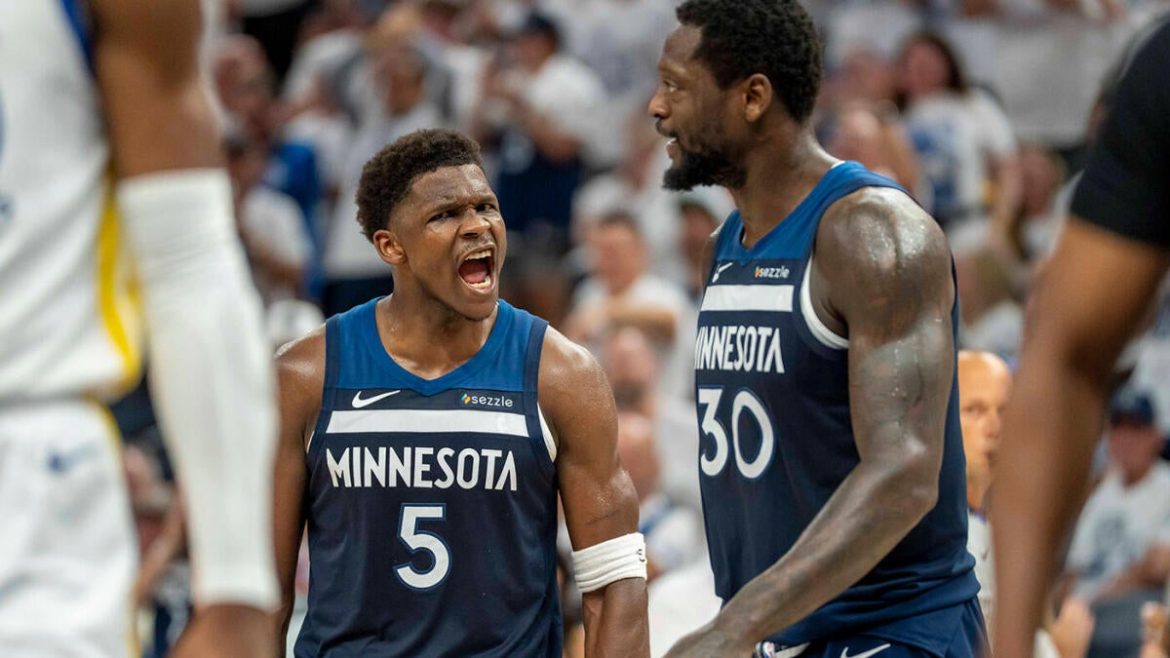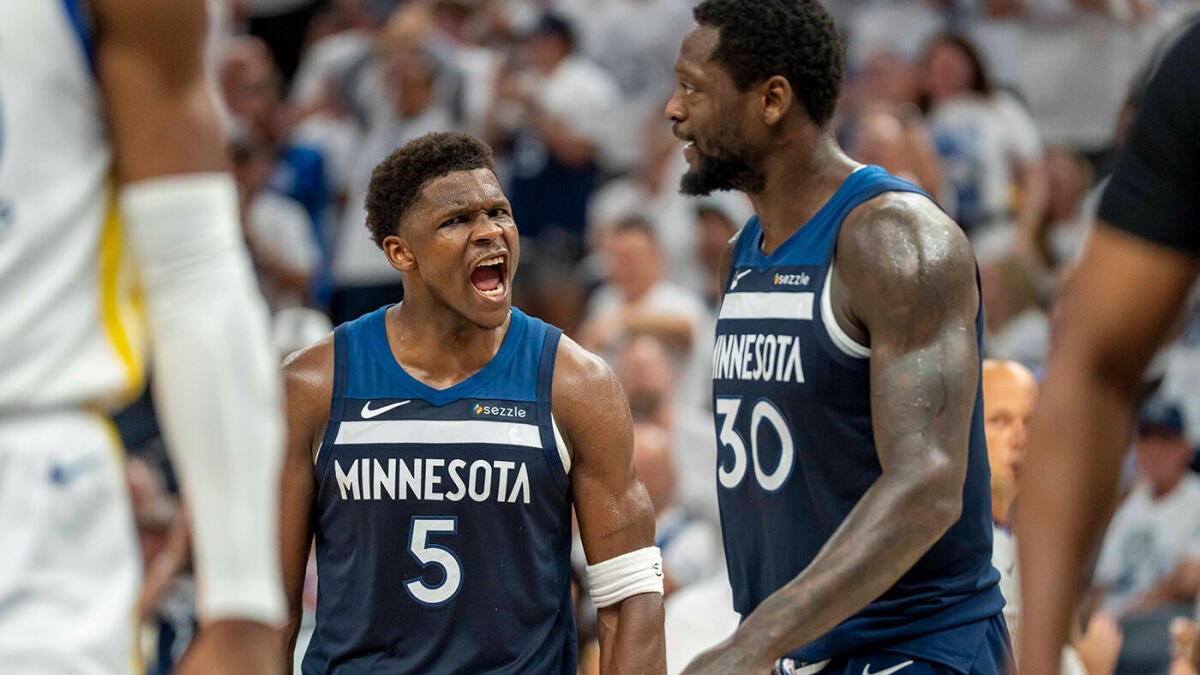The recent series between the Minnesota Timberwolves and the Golden State Warriors has been nothing short of a basketball thrill ride, showcasing exceptional performances from players like Anthony Edwards and Julius Randle. Their combined efforts have not only defined the series but also demonstrated the resilience, talent, and strategic finesse that make playoff basketball so compelling. To understand the significance of this matchup and the impact of Edwards and Randle, it is essential to delve into their contributions, key moments, and the broader narrative that has unfolded during this high-stakes series.
The Rising Stars: Anthony Edwards and Julius Randle
At the heart of the Timberwolves’ success are two standout talents: Edwards and Randle. Both players have emerged as pivotal figures, steering their team through the adversity of an intense playoff series against a formidable Warriors squad.
Anthony Edwards: A Playoff Phenomenon
Anthony Edwards has been nothing short of spectacular. His scoring ability, resilience, and leadership shine through in critical moments. Notably, Edwards has displayed remarkable adaptability—battling through injury, maintaining offensive firepower, and delivering clutch performances. For instance, he scored a game-high 36 points in Game 5, including a crucial baseline three-pointer with approximately 1:19 remaining that helped solidify Minnesota’s lead. His offensive explosion in the second half, especially scoring 28 points after halftime in Game 3, underscores his capacity to elevate his game when it counts most.
Furthermore, Edwards’ leadership extends beyond scoring. His halftime speech in a pivotal Game 4 victory galvanized the Timberwolves, prompting a surge that propelled them to dominate the third quarter. This dynamic ability to influence both the scoreboard and team morale signifies his growing stature as a playoff leader.
Julius Randle: The Double-Double Dynamo
Julius Randle’s performances have been equally influential. His capacity to contribute across multiple facets of the game—scoring, rebounding, and playmaking—has been critical. Randle’s first postseason triple-double, achieved in Game 3, where he posted 24 points, 12 assists, and 10 rebounds, exemplifies his all-around impact. His offensive efficiency is notable; shooting 13-for-18 in a game to accumulate 29 points demonstrates his adept scoring ability.
In the series, Randle’s leadership was evident in clutch moments, especially when the team needed stability. His ability to score, facilitate, and secure rebounds provides the Timberwolves with a versatile offensive threat and a steadiness that balances Edwards’ explosive scoring.
Key Moments and Turning Points
The series narrative is punctuated by pivotal moments that underscore the players’ influence and the overall momentum swings.
Clutch Performances and Game-Winning Shots
The series has featured several clutch moments, but Edwards’ baseline three-pointer in Game 5 with under 1:20 remaining is particularly noteworthy. This shot not only exemplifies his clutch gene but also effectively sealed the series victory, signaling the Wolves’ ascendancy.
Similarly, Julius Randle’s triple-double in Game 3 played a crucial role in securing the victory, demonstrating his ability to contribute in multiple ways during critical junctures.
Defensive and Offensive Dominance
The Timberwolves’ defensive effort, especially during the third quarters—where they held Golden State to as few as 17 points—has been vital. Edwards’ scoring prowess and Randle’s rebounding have disrupted Warriors’ rhythm, preventing them from establishing a consistent offensive flow.
Moreover, the team’s ability to dominate the closing minutes of games—evident in their final quarter performances—has been a hallmark of their playoff resilience. Edwards’ aggressive scoring, combined with Randle’s playmaking, often tilts the game in Minnesota’s favor during the decisive moments.
Overcoming Adversity
Edwards’ injury in Game 2, where he exited with a left ankle sprain but returned to contribute meaningfully, highlights his toughness. This resilience exemplifies the competitive spirit that Minnesota harnesses to challenge traditional powerhouse teams like Golden State.
Series Progression and Series Lead
From the series’ outset, the Timberwolves demonstrated a capacity to recover and adapt. Initial setbacks gave way to strategic adjustments, with Edwards and Randle stepping up to lead Minnesota to a commanding 3-1 series lead. Their performances have been instrumental in this turnaround.
The series has seen the Timberwolves capitalize on their home-court advantage, as well as their players’ burgeoning playoff experience. Notably, the team’s dominant performance in Game 4, where Edwards scored 16 points after returning from injury and Randle contributed another stellar effort, showcased their growing confidence and ability to close out games.
Broader Implications for the NBA Playoffs
The success of Edwards and Randle in this series holds broader significance. Their emergence as clutch performers and leaders signifies a shift in the NBA power landscape. The Wolves, long considered underdogs, are now a formidable presence, thanks in no small part to their rising stars.
Furthermore, their performances challenge the stereotypes of playoff inexperience. Edwards’ poise under pressure and Randle’s versatile scoring and rebounding underscore a maturity that hints at future playoff runs deep into upcoming seasons.
Strategic and Team Dynamics
The Timberwolves’ coaching and tactical adjustments have maximized Edwards’ scoring ability and Randle’s versatility. The team’s offensive schemes often involve Edwards creating his own shot or facilitating for teammates, while Randle acts as the offensive hub, enabling a balanced attack.
Defensively, the team’s focus on disrupting Warriors’ rhythm—exploiting the absence of Stephen Curry in some games—has been key. Edwards’ athleticism and Randle’s intelligence in rotating and contesting shots have been vital when defending Golden State’s perimeter shooters.
The Road Ahead and Future Prospects
The current series momentum, with Minnesota holding a 3-1 advantage, positions the Timberwolves for a likely series victory, barring an unforeseen collapse. Edwards and Randle, having demonstrated extraordinary playoff resilience, are poised to lead the team to the Western Conference Finals.
This matchup has proven that young stars like Edwards can deliver under pressure, and experienced stars like Randle can adapt their game to elevate their team. Their combined leadership provides a blueprint for future success, and their performances serve as an inspiring narrative for the NBA’s next generation.
Concluding Reflection: The Embodiment of Resilience and Talent
The series between the Timberwolves and Warriors stands as a testament to the transformative power of individual brilliance, strategic ingenuity, and unwavering resilience. Edwards and Randle have emerged as emblematic figures—players who seize moments, adapt to challenges, and elevate their team in high-pressure situations. Their performances are not just about accumulating points but about inspiring confidence, galvanizing teammates, and reshaping perceptions.
As the Timberwolves aim to close out the series, their journey underscores a fundamental truth in sports: at the highest levels, perseverance and talent forge champions. Edwards’ fiery competitiveness and Randle’s versatile excellence have transformed the Minnesota Timberwolves from dark horse contenders into legitimate hopefuls for NBA glory. In a broader sense, their narratives reflect a new era where emerging stars and seasoned leaders collaborate to redefine the contours of playoff basketball, promising an exciting future for both the team and the sport at large.





